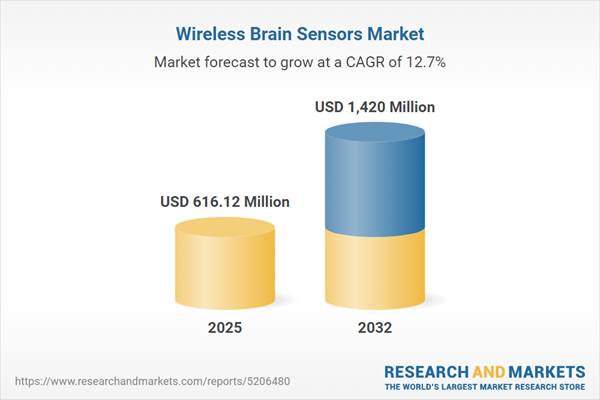Speak directly to the analyst to clarify any post sales queries you may have.
Senior decision-makers in the wireless brain sensors market face an environment defined by rapid technology developments and evolving compliance demands. Gaining a competitive edge in this space requires an agile, informed approach to organizational priorities, regulatory adaptation, and innovation-driven investment.
Market Snapshot: Wireless Brain Sensors Market Growth Outlook
The wireless brain sensors market is projected to grow from USD 545.88 million in 2024 to USD 616.12 million in 2025, with further expansion anticipated to USD 1.42 billion by 2032. This trajectory reflects a substantial compound annual growth rate of 12.71%. Sustained clinical adoption, the integration of sensors into brain-computer interface initiatives, and rapid advancements in artificial intelligence technologies all contribute to this robust outlook. As organizations increasingly leverage wireless sensor solutions, they can more effectively navigate regulatory changes and capitalize on industry innovation. Adoption is broadening across healthcare, defense, and consumer sectors, resulting in more agile decision-making and enhanced operational efficiency.
Scope & Segmentation of the Wireless Brain Sensors Market
- Sensor Types: Invasive sensors enable specialized neurological procedures, such as deep brain stimulation and electrocorticography. Non-invasive options, including wet EEG, dry EEG, fNIRS, and MEG technologies, extend access to diagnostics and consumer applications.
- Applications: Utilization extends to health monitoring, rehabilitation, cognitive evaluation in defense, digital entertainment, and academic research, each leveraging wireless brain sensor technology for precise data and workflow enhancement.
- End Users: Hospitals, home care agencies, military organizations, university labs, and private research entities utilize these sensors to achieve data-led initiatives and meet complex monitoring needs.
- Deployment Modes: Implantable devices are used for specific clinical requirements, while wearable sensor solutions—such as headsets, bands, and caps—address broader monitoring demands across clinical and consumer contexts.
- Components: The core environment relies on electrodes, magnetic sensors, and photodetectors, supported by custom-developed software and integration services for analytics, visualization, and actionable insights from neural data.
- Regional Dynamics: The Americas maintain leadership especially in the United States, Canada, and Latin America. Europe, the Middle East, Africa, and Asia-Pacific covering China, India, Japan, Australia, and Southeast Asia require companies to employ strategic localization and compliance adjustments to address varying market needs.
Key Takeaways for Senior Decision-Makers
- Wireless brain sensors provide adaptable solutions for clinical, military, and consumer use cases, supporting alignment between organizational strategy and day-to-day operations.
- Advancements in non-invasive design increase patient engagement and ease compliance, proving essential for the growing focus on remote and outpatient care models.
- Flexible system architectures allow rapid organizational adjustment to regulatory shifts and emerging market trends, maintaining workflow stability.
- Regional collaboration with local authorities and partners accelerates expansion strategies and fosters durable market presence.
- Enhancements in AI-driven analytics and device size reduction improve the depth and quality of data, leading to accelerated, informed decision-making in clinical and research environments.
Tariff Impact and Supply Chain Considerations
Recent shifts in US tariff policy place a premium on robust domestic and nearshored supply chains. Companies are increasingly adopting modular design to mitigate operational risks and respond flexibly to fluctuating regulatory and logistical landscapes. Heightened process oversight and iterative improvement are reinforcing efficiency and compliance standards across the wireless brain sensors sector.
Methodology & Data Sources
This report combines detailed secondary research with targeted interviews from industry experts in the wireless brain sensors market. All quantitative results use validated methodologies and are cross-checked with up-to-date expert input, ensuring balanced, actionable information for leadership teams.
Why This Wireless Brain Sensors Market Report Matters
- Strategy leaders receive insights on compliance trends and technological advances in the wireless brain sensors market, supporting strategic alignment across regional and operational portfolios.
- The report enables more informed supplier selection and robust partnership development, crucial for success in a shifting regulatory landscape.
- Comprehensive competitive analysis supports optimal resource allocation, sustaining organizations’ positioning in a dynamic sector.
Conclusion
Continued innovation in wireless brain sensors equips organizations to make better decisions, maintain robust compliance, and improve essential workflows. This report supplies the strategic perspective needed to anticipate market evolution and implement resilient, forward-looking strategies.
Additional Product Information:
- Purchase of this report includes 1 year online access with quarterly updates.
- This report can be updated on request. Please contact our Customer Experience team using the Ask a Question widget on our website.
Table of Contents
3. Executive Summary
4. Market Overview
7. Cumulative Impact of Artificial Intelligence 2025
Companies Mentioned
The companies profiled in this Wireless Brain Sensors market report include:- NeuroSky, Inc.
- Emotiv, Inc.
- g.tec medical engineering Gesellschaft m.b.H.
- ANT Neuro B.V.
- Cognionics, Inc.
- Brain Products GmbH
- Neuroelectrics SL
- Blackrock Neurotech, Inc.
- OpenBCI, LLC
- Interaxon Inc.
Table Information
| Report Attribute | Details |
|---|---|
| No. of Pages | 184 |
| Published | October 2025 |
| Forecast Period | 2025 - 2032 |
| Estimated Market Value ( USD | $ 616.12 Million |
| Forecasted Market Value ( USD | $ 1420 Million |
| Compound Annual Growth Rate | 12.7% |
| Regions Covered | Global |
| No. of Companies Mentioned | 11 |









